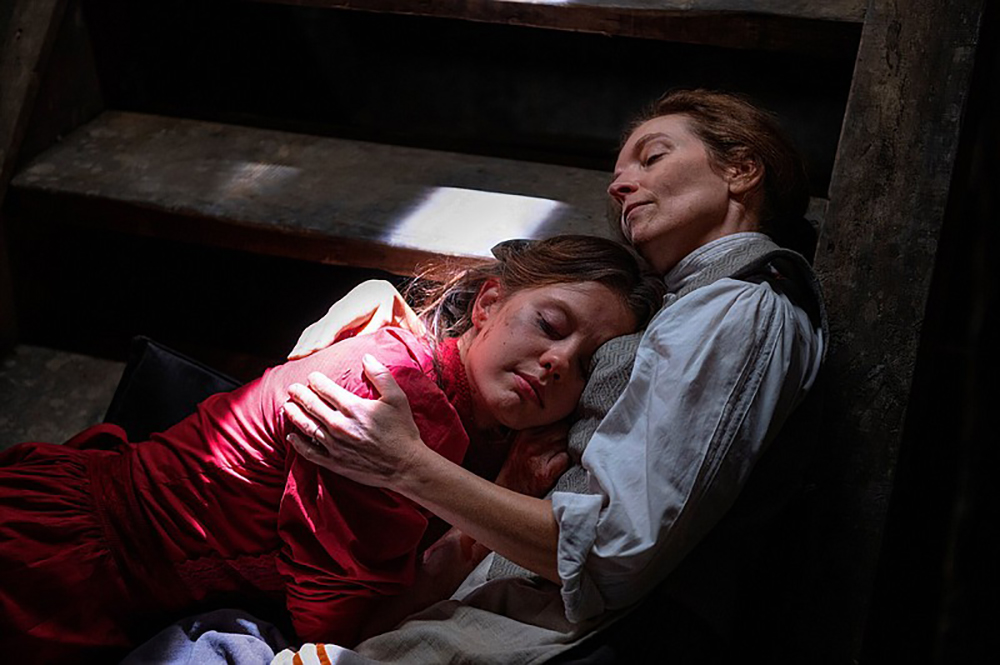This knowledge raises a fundamental question regarding the film’s plot: did Pearl’s mother—who expressed it was her “Christian duty” to keep Pearl on their farm, away from society in an attempt to protect them from her daughter—exacerbate her behavior and accelerate her unraveling? The film further suggests Pearl has been showing concerning behavior for some time, from dismembered doll parts under her bed to the pleasure she self-admittedly finds in harming animals. Though her intentions are good-natured from the perspective of a pious immigrant farmer on the brink of poverty, Pearl’s mother ultimately may have hindered her daughter more than helped. Overall, “Pearl” as a film makes us reassess the connection between isolation and antisocial behavior, as we examine the title character’s unhinged and psychopathic rampage.
Immediate Isolation from Her Parents and her Husband
The primary form of isolation Pearl faces is in relation to her parents. Her mother is particularly at odds with her due to cultural differences that keep them from having a stronger mother-daughter bond. She is rigid in her faith and practicality, finding the fanciful daydreaming of her daughter selfish and foolish. She cannot hide her displeasure with Pearl’s penchant for doing so, and her tone is often critical and irritated.
Confounding this problematic dynamic is her patrolling Pearl and her urgency in keeping her on the farm, having witnessed concerning behavior from her daughter and believing society will not accept her once they become aware of her antisocial behavior. A 2016 study sought to explore the nature of parent and child relationships, how they change as children enter young adulthood and better bond with parents, and the implications for potential displays of antisocial behavior. Previous literature suggests that “as children move through adolescence and into young adulthood, there is increased demand for autonomy. How parents respond to these shifts in the parent-child relationship will largely inform future relationship quality” (2)

This dynamic was an element lacking in the relationship between Pearl and her mother. Johnson, Giordano, Longmore, and Manning’s study (2), anticipated that shifting levels of attachment would be associated with variations in involvement in antisocial behavior, with increased attachment and less harsh parenting buffering children from displaying antisocial behavior. They also posited in this same study that, “In contrast, parents’ continuing or escalating pattern of reliance on harsh parenting and deteriorating parent-child relationships may be implicated in their children’s continued antisocial behavior involvement as they transitioned from late adolescence to young adulthood.”
Isolation and Smothering as a Precursor to Antisocial Behavior
Their results yielded findings that, “highlight that…the parent-child bond displays variations over time that influence trajectories of antisocial behavior.” Relating to Pearl and her relationship with her mother, their result also suggests that “within-person level findings demonstrate that to the degree youth enjoy an increase in parent-child bond quality, this does correspond to a decrease in levels of antisocial behavior.”
The latter supports my claim that Pearl’s mother may have directly influenced her daughter’s ill behavior. Specifically, the continuation of strict parenting and disregard for Pearl’s autonomy may have directly contributed to her antisocial behavior. If the two came to a relationship based on mutual understanding, the propensity for which Pearl engaged in such behavior to the extreme extent we see in the film may have been avoided.
The Spanish Flu—Mirroring Covid-19 Pandemic Isolation
Pearl also suffers from isolation from her ill father due to complications from the Spanish Flu. She thus has no parents which she can find nurturing and must internalize most of her wants and desires. The only “individuals” Pearl seems to have meaningful conversations with are her family’s barnyard animals, who cannot communicate back, indicating how isolated from humans she has become.
Pearl also deals with isolation from her husband, Howard, due to his ongoing participation in World War I. In her monologue, she expresses hopes that Howard would provide a way to escape from the farm. She also expresses frustration toward him for leaving her alone after signing up to join the war. This enduring marriage to Howard and the societal attitudes around being a married woman in 1918 also lead to Pearl’s isolation from other men. She prolongs sexual desire to the point she reenacts sexual intercourse with a scarecrow in a cornfield, indicating severe levels of sexual frustration. Her family’s inability to hire farmhands as they once did—and a good number of men deployed for the war—limit her ability to interact with men. The town is also far away; and as previously mentioned, her mother tries to monitor her and prevent her from leaving the farm.
Isolation from Others Due to Socioeconomic Position

Mitzy, Pearl’s sister-in-law, is close to her age, but Pearl feels separated from her by their differences in socioeconomic status. Pearl sees herself as a poor farm girl compared to Mitzy and believes everything has come easy for her. Mitzy’s preoccupation with parties and dances contrasts with Pearl’s inability to leave her homestead.
(*Spoilers*) Pearl murdering Mitzy illustrates the aggression and misplaced resentment she has towards her. The film never shows Mitzy as viewing Pearl as inferior, instead depicting her as one of the most humane and good-natured people in Pearl’s life. Blinded by her perceived difference from Mitzy, Pearl justifies resenting her in a way typically associated with antisocial behavior. Pearl states, “it’s not about what she wants—it’s about making the best of what she has.”
Psychopathic murderers often believe it is themselves against a world that does not understand them. This flawed logic results in their delusional belief that they have justified privileges allowing them to participate in harmful antisocial behavior suggestive of a complete disconnect with humanity (3). When Mitzy meets her demise in the film, Pearl has lost her sense of humanity and has come to justify her behavior with the notion that life has dealt her less than favorable circumstances, and thus she deserves vindication. All of which allows her to murder with no real sense of remorse.
Isolation Due to Geographical and Environmental Circumstances
Widening our lens beyond the immediate isolation within Pearl’s life personally, there is also the isolation she faces from living in a rural area and the ongoing Spanish Flu pandemic. Obviously, given the state of our own world in 2022—as we ride out what seems to be the last lingering moments of the Covid 19 pandemic—it is not hard to understand how frustrating and lonely these extended periods of social distancing can be. The Spanish Flu would continue for another two years from when the events in the film took place.
This enduring nature of the pandemic explains the fear the characters have regarding contracting and spreading the “bug” as they refer to it. Given that 1918 lacks the century of scientific advancement 2022 has, their fearful reactions are not unwarranted either, as many would not understand the nature of how viruses spread through respiration and touch. Pearl’s mother so fears contracting the virus she will not let her bring in artifacts from outside the home, such as the hat Pearl finds. Everyone in the town is wearing masks, and the movie theatre is noticeably empty when Pearl goes to see a film.

The farm on which Pearl grew up seems to be the bane of her existence. As the film depicts, it is a day-long travel to the town, and Pearl repeatedly states her longing to leave the farm and pursue her dreams as a movie star. She clings unhealthily to the dance auditions she agrees to attend with Mitzy. Securing a spot with the traveling dance company begins to seem like a narrowing opening to escape the farm.
Pearl’s Desire to Break Out of Her Circumstances ‘At All Costs’
The resistance her mother expresses upon hearing her intentions to audition leads to the beginning of Pearl’s unraveling as she comes to see her mother as an obstacle from her leaving the farm. Meanwhile, her desire to absolutely leave has grown to a frightening level of importance for her. We see the same urgency rear its head when the unnamed projectionist becomes frightened of Pearl and tries to distance himself from her after arriving at the farm. Pearl notices the shift in his mood and, after realizing he will no longer be following through on his proposed plans of taking her to Europe, (*spoilers*) she murders him, screaming, “I am getting off this farm!” Her longing has turned into delusional urgency, motivating her to use murder to remove any obstacle she faces in escaping the farm.
If we infer Pearl has been trapped on the farm most of her youth and has shown signs of problematic behavior since then, we can conclude she’s faced isolation since a young age. Chronic isolation from youth has implications for detrimental behavior later in life that are unique to isolation chronically experienced in adulthood (1). Every character in “Pearl” faces isolation to some degree, either from the pandemic or their personal relationships (eg. Pearl’s mother feeling disconnected from her daughter and husband). It’s a sound assumption that Pearl’s isolation has existed for a longer period, extending from childhood to young adulthood, imposed by both her mother and her external circumstances. In contrast to most of the adults in the film who are just now experiencing isolation through the pandemic, Pearl has faced isolation most of her life, which would explain why her behavior is uniquely violent to a psychopathic degree.
Understanding Pearl’s Behavior, Not Condoning It
Attempting to escape her longstanding loneliness, Pearl packs her bags, convinced she will win the upcoming dance competition and go on to travel with the dance company throughout the state. She begins to make all-or-nothing statements suggesting that losing is not an option. Pearl, as previously mentioned, spends most of the film daydreaming about being famous. Her perception of being lonely results in this continued rumination which may be her way of coping with the culmination of isolating factors described previously (1).

Although aspiring for fame is not anything out of the ordinary, Pearl’s sense of ultimatum regarding becoming famous suggests delusions of grandeur. Her hysterical crying after being informed she is out of the running for the spot with the dance company and her inability to cope implies insecurity and poor self-esteem. Pearl displays many facets of antisocial behavior often associated with psychopathy, and although this does not make her actions excusable, these concerning displays of behavior make us question if her own demise and the demise of her victims were avoidable.
Discussion
“Pearl” has the rare distinction of being a successful horror film that succeeds in providing chills long after an initial viewing. “Pearl” also succeeded in making me reflect on our world. 2022 is a year when Jeffrey Dahmer is having something of a rebirth, antisocial behavior captured in real-time via recording assaults us daily due to its pervasiveness within our social media algorithms, and our collective experience with a pandemic comes to an end. “Pearl” offers much to digest as a story that seems to run parallel with current themes in society. What consequences have the last two years of pandemic-driven isolation had on us? Perhaps it is time we start exploring the nature of antisocial behavior deeper and how we exacerbate it. Psychopathy is not a medically recognized descriptor, but rather a culmination of perceived antisocial behavior at a level detached from human emotion to an extreme extent.
We tend to view those described as psychopathic as being cold and threatening to society. Perhaps like in “Pearl,” there is urgency in keeping those displaying such repellent behavior isolated from the population. It may be time to rethink this approach, not as a means to justify the actions at this level of monstrousness, but to prevent them altogether. Psychopaths can suffer emotional pain for a variety of reasons. As evident in “Pearl” and adhering to psychological professionals, psychopaths do desire to experience the human ability to be loved and cared for but are aware, to a degree, of the effects their polarizing behavior has on others (3).
Of Striking Vulnerability and Emotional Pain
Pearl’s character feels pathetic and tragic. We watch as she goes past the point of no return, but the film renders Pearl’s circumstances understandable enough that there is a yearning to stop her before she reaches the point of no return. Watching her struggle to understand her behavior and how others interpret it is frightening and palpably uncomfortable. We watch in real time as a troubled girl murders her way into becoming a monster and we are left with many unsettling questions in the process.

In a popular article from Psychiatric Times, Martens expresses concern regarding rehabilitation of psychopathic behavior and suggests a more sympathetic approach, as he writes:
“Studying the statements of violent criminal psychopaths sheds light on their striking and specific vulnerability and emotional pain. More experimental psychopharmacotherapy, neurofeedback, and combined psychotherapy research is needed to prevent and treat psychopathic behavior. The current picture of the psychopath is incomplete because emotional suffering and loneliness are ignored. When these aspects are considered, our conception of the psychopath goes beyond the heartless and becomes more human.”
Does ‘Pearl’ Contain Warnings for Modern, Post-Covid Society?
Marten’s claims regarding emotional suffering and loneliness are on target. We tend to react without seeking to understand why in a means to prevent abhorrent behavior. Pearl is, without doubt, irredeemable by the end of the film, but would an understanding of the loneliness and emotional suffering she faced, along with proper treatment, have prevented her descent into madness? If so, what implications does this film have for our society as we navigate a time of post-pandemic isolation?
Pandemics do not, a psychopath make, but as I have sought to argue, individuals already displaying antisocial behavior and facing isolation may have issues reacclimating to society after such a long period of chronic isolation. Lee Et al. suggest that “Considering pandemics and other socially disruptive events are likely to occur again, proactive research into the costs of social isolation can mitigate the effects of an uncertain future” (1). Their creation of a conceptual framework sought to study the neuroactivity during social-homeostasis leading to antisocial behaviors in organisms after prolonged isolation compared to shorter periods of acute isolation that lead to prosocial behaviors (1).
Preventing Life from Imitating Art

Considering the previously mentioned findings and the implications chronic isolation has for detrimental human behavior, as well as the misunderstandings individuals like Pearl still face, perhaps it is best we work to prevent life from imitating art as it pertains to Ti West’s 2022 film.
*Note: this essay contains references to academic works. Click on the hyperlinks of the various numbers in parentheses to access reference page and the corresponding citation.
Support the Site: Consider becoming a sponsor to unlock exclusive, member-only content and help support The Movie Buff!

